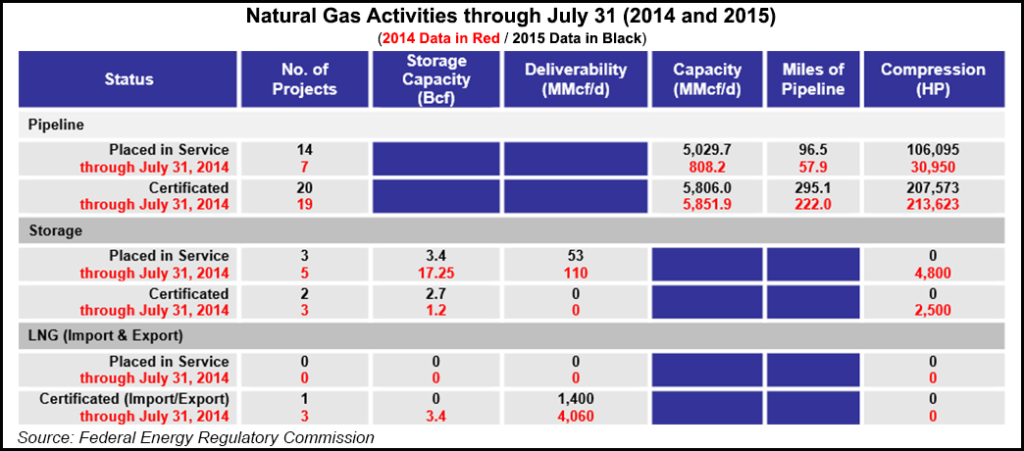Regulatory | Infrastructure | NGI All News Access
Wind Blowing By NatGas on New Power Gen Capacity, Says FERC
Natural gas is taking a back seat to wind power in terms of newly installed power generation capacity in 2015, but it still has a big lead over all other fuels in terms of total installed operating generating capacity, according to data from FERC.

Meanwhile, the Federal Energy Regulatory Commission’s latest Energy Infrastructure Update (EIU) showed three natural gas pipelines were placed into service in July, while two were certificated and nine were proposed. The month also saw one gas storage facility placed into service and one proposed, as was a single facility to export liquefied natural gas (LNG).
According to the EIU, which is compiled by FERC’s Office of Energy Projects, a total of 174 power generation units with a combined installed capacity of 4,958 MW have been placed into service so far in 2015 as either newbuilds or expansions. Of those, 23 units were gas-fueled units totaling 1,866 MW. But the 20 wind units installed so far this year have a combined 2,119 MW of installed capacity, making it tops by that benchmark. Solar was a distant third with 715 MW from 99 units.
By comparison, at the same time last year natural gas accounted for more than half of installed capacity — 3,327 MW from 32 units, or 51% of the total 6,628 MW from 340 units. Solar was in second place in terms of installed capacity (1,576 MW from 197 units) and wind was third (1,265 MW from 27 units).
Natural gas leads in terms of total installed operating generating capacity, with 496.15 GW, or 42.7% of the total 1.16 terawatts (TW). Coal is a distant second at 26.1% (311.8 GW).
FERC said the three natural gas pipelines placed into service in July, which would collectively add 1.54 Bcf/d of capacity and measure 9.5 miles, were:
During July, FERC also certificated two pipeline projects with a combined capacity of 275 MMcf/d and measuring 12.9 miles in length. Of note was DBM Pipeline receiving authorization to own and operate its existing Ramsey Residue Line in Reeves County, TX, as a jurisdictional pipeline. It will provide all 275 MMcf/d of capacity from the Ramsey processing plant to an interconnection with the El Paso Natural Gas pipeline.
Venture Global Plaquemines LNG began the pre-filing process at FERC in July. The company hopes to construct and operate an LNG export terminal in Plaquemines Parish, LA (see Daily GPI, July 7).
According to federal regulators, 14 pipeline projects totaling 96.5 miles were placed into service between January and July 2015, which combined account for 5.03 Bcf/d of capacity and 106,095 hp of compression. By comparison, over the same time period in 2014, seven pipelines totaling 57.9 miles were placed into service, with 808.2 MMcf/d of capacity and 30,950 hp of compression.
FERC said three gas storage projects have been placed into service this year, with 3.4 Bcf of storage capacity and 53 MMcf/d of deliverability with no compression. By comparison, five storage projects were placed into service for the same period of 2014, with 17.25 Bcf of storage capacity, 110 MMcf/d of deliverability and 4,800 hp of compression.
For its reporting on new in-service generation and total installed operating generating capacity, FERC used data provided by Velocity Suite, ABB Inc. and The C Three Group LLC. The Commission used data compiled internally for its report on natural gas activities.
© 2024 Natural Gas Intelligence. All rights reserved.
ISSN © 1532-1231 | ISSN © 2577-9877 |
